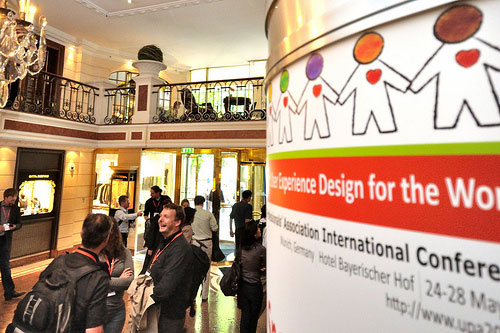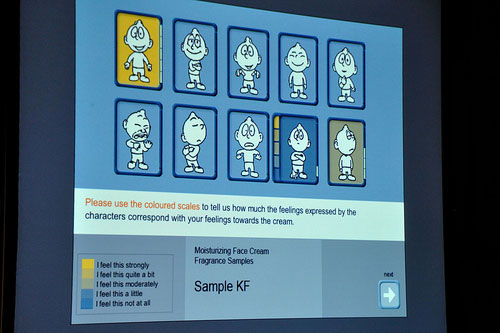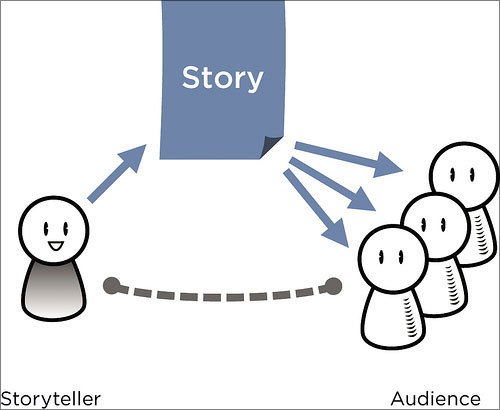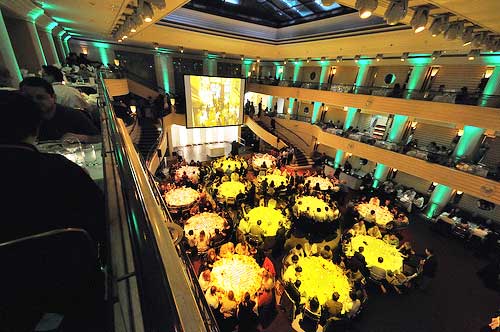International UPA 2010 Conference User Experience Design for the World
We were fortunate enough to attend the UPA 2010 International Conference [2] which was recently held in the Bayerischer Hof Hotel in Munich, a beautiful hotel which has accommodated numerous famous guests in the past ranging from Paris Hilton to the Dalai Lama. The conferences main focus this year was on how UX professionals can create great user experiences across different cultures. Over 700 people who work in the user experience field attended, with a more international crowd than ever, mainly due to the fact that it was the first UPA conference held outside North America.
As members of the JISC-funded AquaBrowser User Experience (AquaBrowserUX) Project [3][4], we were very interested in discussions which centred on user research methodologies in particular. A key methodology used in the AquaBrowserUX Project is user research which involves a field study undertaking contextual inquiry, a form of user-centered design. It is related to ethnographic study of users in their natural habitats, involving real-use scenarios. This field study involves gathering data from Edinburgh University Main Library users in situ, with the aim of understanding the background of visitors, their exposure to AquaBrowser (a leading library resource discovery product with faceted search User Interface) and their information-seeking behaviour.
The method provides broader understanding of how systems fit into working environments and uncovers common user behaviours and patterns of use. Moreover, it complements other qualitative methods which are also being employed in the project including surveys and interviews, which are all part of the data-gathering process for persona development [5].
This article summarises the presentations which we attended over the course of three days in Munich and were most relevant to the AquaBrowserUX area of work. These included sessions on Thursday which focused around ethnography (a term loosely applied to any qualitative research project where the purpose is to provide a detailed, in-depth description of everyday life and practice), persona development (development of archetypal users that represent the needs of larger groups of users, in terms of their goals, behaviour and attitudes), and effective design.

Figure 1: Conference registration morning in the Bayerischer Hof Hotel, Munich [1]
Wednesday 26 May 2010
Designing for Happiness, Sleeping Demons and Guardian Angels
Pieter Desmet, Delft University of Technology
Dr Pieter Desmet took the last session held on Wednesday afternoon where he discussed the role of product design in emotional experiences. This presentation was expected to be interesting as it dealt with a subject that is difficult to measure or quantify. Pieter described how elusive emotional design is, and that often designers must trust their instincts. He said that although they are not easy to design for, all products develop emotions, making them too important an issue to ignore. Emotions can make products successful or make them fail, therefore emotion must be part of the design process. Statistics show that 60% of returned products are returned not because they don't work, but because they just don't feel right!
The ability to design products with a positive emotional impact is of great importance to the design research community and of practical relevance to the discipline of design. Emotion is a central quality of human existence, and most of our behaviour, motivation and thought is enriched with, and influenced by, our emotions. A product, or using a product, can elicit disappointment, attraction, shame, pride, disgust, contempt, admiration, satisfaction, fear, anger, and any other emotion a person may experience in response to events, people, or the actions of people. Ignoring the emotional side of product experience would therefore be like denying that these products are designed, bought and used by humans.
During the talk, Pieter discussed the role of product design in emotional experiences, and proposed some opportunities to develop design strategies to conceptualise products that contribute to the happiness of their users. He referred to 'sleeping demons' as concerns inherent within users which designers do not want to wake. Often designers spend too long concentrating on solving problems or removing negative emotions from a design. This bias in appraisal theory means the focus is often unduly narrowed. New theories are being developed which focus more on positive emotions. Broaden and Build Theory deals with thought action patterns which broaden the design focus to discover and build on personal resources to help people flourish and be happy.

Figure 2: A scale used to measure emotion in the Designing for Happiness presentation [6]
The 40% theory states that happiness originates from three areas: 50% temperament or genes with which we are born; 10% depends on personal circumstances; and 40% originates from conscious thought. This suggests that learning to be happier is learning how to think differently (e.g. positive thinking). This leaves the question of where emotion fits into design. Pieter succinctly answered this question using a metaphor: 'you cannot make a sail trip without a sailboat'. Products affect our happiness as sources, as resources to be used in obtaining goals and as sources of meaning: design for rich experiences (to savour), design for engagement (to find or identify and attain goals) or impact of positive emotions on human product interactions (fascination). This reiterates his point on the importance of designing for happiness as much as designing to solve problems and remove negative emotions.
Pieter also pointed out that it is possible to enjoy things which incite fear, for example, horror films, dangerous sports, rollercoasters, etc. We can enjoy negative emotions as long as conditions such as barriers are placed between the user and the 'danger'. This should therefore also be taken into consideration in designing for happiness. Overall, this session provided a lot of focus on the psychological side of design and generated some useful discussion at the end of a very engaging day.
Using Stories Effectively in User Experience Design
Whitney Quesenbery and Kevin Brookes, Motorola
This session focused on how we can use stories to collect, analyse and share qualitative information from user research to help create usable products. This was a great presentation to kick off the conference as Whitney and Kevin were very engaging and talked passionately about the subject. They were also buoyed by the level of contribution from the audience. It was quite a fun session as we got to try some listening exercises where we were given a minute to speak to the person sitting next to us whilst they listened. The aim was to work in pairs with the speaker talking for 1 minute about something relatively comfortable while the listener just listened (without talking, interrupting or filling any silences). I found myself having to resist the urge to speak during the exercise, but we learned that if we allow speakers to proceed to the next idea without interrupting them, they tend to dig a little deeper to fill any potential silences, giving you even more information up-front.
Whitney and Kevin taught us that learning to listen and when to speak are important when seeking information from someone that is difficult to obtain. Often those small throw-away comments are not noticed by the storyteller, but if we know how to identify a fragment that can grow into a story, we often uncover information which illuminates the data we have collected. This sort of 'juicy' information often surprises us and contradicts common beliefs; it is invariably clear, simple and most of all, compelling.
The session went on to examine what constitutes a story. A story is shared by everyone who hears it. First the storyteller shapes the story and as the audience listen, they weave the story together. The storyteller and the audience each affects the other and shapes the story they create. A story is shared by everyone who hears it, but is heard by each person in his or her own way. We have to be sure that what they are hearing is the same story. The relationships around a story are called the Story Triangle and relationships shift as you move from audience to the storyteller (Figure 3).

Figure 3: The Story Triangle for a written story.
Each person in the audience has his or her own connection to the story [7]
When people have a bad experience, they often tell you the story of what their experience is. Telling stories is a natural way for people to communicate. When carrying out user research, in order to collect stories we should try to incorporate it as part of what we are already doing; for example, if we are doing ethnography, why not just add this task to what we are already doing? A good tip here is to structure the discussion to encourage stories.
Whitney went on to give an example of a time when she had been interviewing a lady for an hour. The lady had answered all the questions on the survey, and once she felt that her duty was done, only then did she really open up in a more relaxed conversational manner and share some of her real experiences. In effect, the subject gave the interviewer valuable insights which she probably believed were not relevant during the earlier structured interview. This example proves the point that sometimes a more conversational and relaxed approach works better in gaining insights into what people really think and do.
The talk then progressed onto how we can use stories to add to personas the richness which is often lacking. By using stories we can put a bit of the richness back. For example, when communicating a persona's needs and goals, we can create a story around the data to give them a more realistic feel. Stories in personas can provide perspective, generate imagery to suggest emotional connections, and give the persona a voice through the language used. However, one ethical issue to consider carefully is how we re-use the words our subjects have used; for example, deciding whether to use their exact words or not, and how to use language in a way that communicates who they really are.
Stories can also be used to create scenarios for usability testing. Often tasks force the participant to do something they might not ordinarily do. If we can create a scenario and ask the participants to 'finish the story', it's often easier for them to imagine themselves in the situation and realistically attempt the task. A good example came from an audience member who stated the problems she had had when asking women to try to record a football game using a prototype user interface (the prototype did not allow for any other task). The women would be very unlikely to record such a thing in normal circumstances and so struggled to attempt the task. When the facilitator changed the scenario by adding a story, the women were much happier to attempt the task: 'Your boyfriend is out and has asked you to record the football for him, can you do this?'
Stories can also be collected during usability tests. The opening interview is often an opportunity to collect stories and use them to set up a task. Doing so allows us to evaluate the tasks and check that they match participants' stories while also allowing us to generate a new task from the story.
In keeping with the cultural theme of this year's conference, Whitney and Kevin discussed the cultural differences in storytelling. Asian cultures tend to tell stories in a spiral way; to whom we are connected through our environment, family, colleagues, etc. This changes the structure of how they tell the story compared to Westerners. It is also important to think about who is telling the story and how this changes, based on whom they are telling it to. For example, if talking to teenagers, it might be better to interview them in pairs as they might talk between themselves more readily than talk to someone older to whom they cannot relate so easily.
There was so much to learn during the presentation; ideas on things which might seem obvious but are very often overlooked. The overriding message from this presentation was the importance of listening; asking a question such as 'tell me about that', and then just listening! Overall we found this to be a very enjoyable session with lots of useful discussions and exercises relevant to the work currently being undertaken in the AquaBrowserUX Project.
Thursday 27 May 2010
Ethnography 101: Usability on Plein Air
Paul Bryan, Usography Corporation
Paul Bryan spoke about how studying users in their natural environment is key to designing innovative, break-through Web sites rather than incrementally improving existing designs. As our AquaBrowserUX Project is currently employing this method, this presentation seemed essential in order better to understand all that's involved. Paul provided a very interesting insight into running such studies, explaining when to use ethnography and outlining a typical project structure. In response to my question over the right number of participants required for a study, Paul replied with, 'it's a bit like love, you just know'. I have never before heard such a commonly asked user research question answered so eloquently.
Ethnography clearly takes a lot of time and people-power to conduct a thorough study. It seems that as a result, only large companies (or possibly academic institutes) get the chance to do it which is a shame because it is such an informative method. For example, all video footage recorded must be examined minute by minute and transcribed. When it comes to analysing the data collected, Paul suggested a few useful techniques. Using the transcribed footage, go through and develop themes (typically 5-10). In the example of a clothes shopping study this may be fit, value, appeal, style, appropriateness, etc. Creating a table of quotes and mapping them to coded themes helps to validate the theme. He also recommended that we focus on behaviour in ethnography, capture cases at opposite ends of the user spectrum, and always look for unseen behaviours.
Paul also mentioned how Ethnography has gone mainstream, referring to the film Avatar as a perfect example. He also made reference to 'Webnography' (digital ethnography), which at its simplest is merely the application of new technologies to the process of ethnography.
At the end of the session we took part in a research exercise where we had to plan an ethnographic study to support the design of a hypothetical mobile e-commerce application. The session generated lots of questions and feedback from the audience and was very informative and enjoyable, one of the most engaging and interesting of the conference.
Creating Richer Personas: Making Them Mobile, International, and Forward Thinking
Michele Snyder and Anthony Sampanes, Oracle Corporation
This short presentation provided lots of information relevant to the project as it is something which we are currently undertaking. Michele Snyder and Anthony Sampanes gave an engaging talk on how personas are a great way to get development teams in sync with a new space and their users. Traditionally personas are limited to desktop users. However, this is changing as doing things on the move is now possible with the aid of smartphones and other mobile devices. The revelation from the presenters that they had found little literature on cross-cultural or mobile personas provided a strong argument for more research to take place in this area.
Michele remarked that when you get into the mobile area, you start seeing some multicultural differences. Mobile users are different, they differ greatly both in the way they accomplish tasks and in their operating environments, so we have to consider mobile users as a very heterogenous group of users.
As part of an in-house project, they captured key tasks which mobile users were interested in completing and carried out interviews with people they recruited in addition to ad hoc testing in which they approached people in the streets. The aim of the interviews was to get as much information about the context of use as possible. They also persuaded users to create a photo diary, taking pictures of the things they were doing at particular times of the day. The photo diary approach was an especially useful method, when gathering data on user behaviour, as it goes much further than regular testing methods.
Anthony explained how the project team collated all the information gathered and ported it into personas, making sure that the set of persona represented all of the different cultures on which they wanted to portray information, making them 'forward-thinking personas' since technology in the mobile space is advancing rapidly, much more so than in other environments. The final personas included a variety of information and importantly, images from the diary study as well. Sections included 'About Me', 'Work', 'Mobile Life' and 'My Day'.
They also wanted to be able to provide enough information about the personas so that they acquired longevity and did not become outdated. To do this, they encouraged the participants to 'think outside the box' about things they would like to do in the future. To incorporate a forward-thinking section called 'Mobile Future', researchers asked participants what they would want their phone to be able to do in the future that it could not currently do. This provided an opportunity for the personas to grow and not become outdated too quickly. The resulting personas were reportedly a huge success and were widely used across various product teams.
The danger of outdated or dead personas represents a continual battle for design teams; so much so, that it was the topic of discussion at one of the lunch events the previous day. It was great to see how one organisation has tried to address this issue.
Conclusion
At the end of a captivating three days, it is fair to say that we both returned from the conference inspired by the variety of topics and range of speakers involved. The conference organisers did a great job of providing delegates with a whole programme of events and activities to help people meet others with the same interest. Activities included the lunch gatherings which focused on getting groups of people together in designated restaurants around Munich at lunchtime with the aim of discussing different flavours of Usability. This was especially helpful for networking with like-minded people who provided inspiration and ideas for new ways of working.

Figure 4: Conference Dinner [8]
The highlight of the social events was Thursday night's elaborate conference dinner which provided delegates with a true Bavarian feast including traditional German music. This dinner not only provided the opportunity to reconnect with delegates we met during the course of the conference, but also one last opportunity to meet new people. There was also an award ceremony which recognised the work of those in the industry and all the people that work behind the scenes to make the conference happen each year.
Overall, the conference proved of value to the work currently being undertaken on the AquaBrowserUX Project. Who knows, maybe next summer we might even get a chance to share our research with everyone in Atlanta 2011.
References
- Figure 1: Registration morning in Bayerischer Hof Hotel
http://www.flickr.com/photos/50646585@N07/4652439727/in/set-72157624035162609/ - Embracing Cultural Diversity - UPA International Conference, May 2010
https://www.usabilityprofessionals.org/conference/2010/ - AquaBrowserUX Project Team
http://lorrainepaterson.wordpress.com/2010/05/19/AquaBrowserux-project-plan-5-project-team-and-end-user-engagement/ - User Study of AquaBrowser and UX2.0
http://boonious.typepad.com/ux2/2010/04/AquaBrowserux.html - AquaBrowserUX Digital Library Personas
https://www.wiki.ed.ac.uk/display/UX2/Digital+Library+Personas - Figure 2: Designing for happiness slide
http://www.flickr.com/photos/50646585@N07/4652589523/in/set-72157624035162609/ - Figure 3: Story Triangle image http://www.flickr.com/photos/rosenfeldmedia/4459979698/
- Conference Dinner http://www.flickr.com/photos/50646585@N07/4653317044/in/set-72157624035162609/
